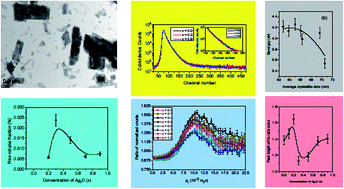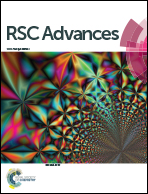Positron annihilation studies and complementary experimental characterization of xAg2O–(1 − x)(0.3CdO–0.7MoO3) metal oxide glass nanocomposites†
Abstract
Metal oxide nanocomposites of the composition xAg2O–(1 − x)(0.3CdO–0.7MoO3) were prepared by a melt-quenching method and were characterized by different experimental techniques like X-ray diffraction, high resolution transmission electron microscopy and optical absorption spectroscopy. X-ray diffraction showed sharp diffraction peaks indicating large crystallites but transmission electron microscope images also showed crystallites of nanometer dimensions in appreciable concentrations, which confirmed the nanocomposite structure of the samples. Although the lattice constants did not show significant changes with the increase in concentration (x) of Ag2O, there is considerable relaxation of the growth-induced strain above x = 0.2. Interestingly this is also the concentration above which the optical band gap energy showed a mild decrease. One salient feature of this study is the use of positron annihilation spectroscopy for identifying and monitoring the structural defects such as vacancies and vacancy clusters as well as the free volume cavities during the change in concentration of Ag2O. Positron lifetime measurements indicated trapping of positrons initially in the interfacial defects within the 0.3CdO–0.7MoO3 nanocrystalline ensemble and then in the free volume defects within the amorphous Ag2O matrix. At higher Ag2O concentrations, positron trapping appeared to take place within the Cd2+-monovacancies in CdO and in the divacancies of neighbouring cationic and oxygen monovacancies in the α-MoO3 and CdMoO4 nanocrystallites. At x = 0.1–0.2, the effective positron trapping centres are translocated to the tetrahedral Mo6+-monovacancies instead of the Cd2+-monovacancies. The results of coincidence Doppler broadening spectroscopic measurements, which map the electron momentum distribution and its variations, indicated increasing trapping of positrons with increasing concentration of Ag2O, which again is attributed to the trapping sites in the increasing number of nanocrystallites being formed.



 Please wait while we load your content...
Please wait while we load your content...